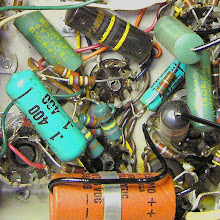Now I'm finally going to get down to talking about biasing. Instead of giving a wordy definition of bias I'm going to try to focus on some details of the circuit that will give you an intuitive sense of what bias is and why we need it. Once you have a grasp of those the textbook definitions should begin to make more sense.
Part 4 of the preamp bias posts showed where to connect your meter leads to measure the B+ voltage, plate voltage and grid voltage in the first 12AX7 gain stage in a Champion 600. Those measurements will all come into play later on. Right now we're going connect the meter in another way to read the cathode voltage.

Zooming in on the schematic, we see this label (which I've highlighted in blue):

It says +1.7 VDC / TP6. This means we should see a reading of positive 1.7 volts of DC at Test Point Six. The line extending from the label box indicates where the meter would be connected to take this reading.
All of the test point measurements (and in fact the majority of the measurements you'll take inside any amp) are "referenced to ground". What that means practically is that the point you connect the black lead of you meter should have no components between it and ground.
This is the symbol for ground on a schematic:

So looking back at the schematic above you'll see that the way our meter is connected is measuring the cathode voltage "referenced to ground".
Now back to our cathode resistor. Since a capacitor blocks DC current and it's a DC measurement we're concerned with we'll ignore the cap for the moment:

That leaves us with 1.7 volts measure across a 1.5K resistor. That means we have enough information to calculate the current through the resistor using Ohm's law.

1.7 volts divided by 1,500 ohms is .0011 amps - or 1.1 ma.
It's no mistake that this 1.7 volts at the grid and 1.1 ma of current fall right at point C on the graph of plate curves we've been looking at:

The circuit designer chose point C to be the bias point. Given the load line they had to choose the 1.5K resistor to make that happen. The next post will explain why.




6 comments:
Well, where's the next post.
You explained the dC load line, now it's time for the AC line as you promised :)
Ike,
check a post in april : step 6a
Sorry, it stops at 6a. 6b would have been the intersting part :(
hey Guys,
I didn't realize anyone was actually reading these.....seems like most of the traffic has been on the mod posts and the step by step stuff. Glad to see some people interested in the theory side of things. I'll try to write up a 6B this weekend.
best, Andy
haha, ya, I still check back every so often to see how the cliffhanger will unfold! I've learned a tonne from your site, Andy, have successfully modded my Champion 600 and just bought a Valve Junior to mod too... All thanks to you and your clear explanations, they're the best on the net! Still trying to *understand* how bias affects tone, particularly what changes as you shift the bias along the load line....
thanks for the bias tutorial! very good.
Post a Comment